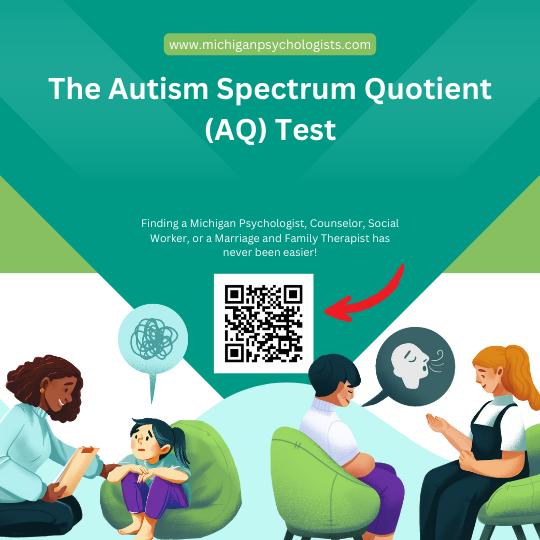The Autism Spectrum Quotient (AQ) Test
Home » Psychological Tests » Autism Tests and Screeners » The Autism Spectrum Quotient (AQ) Test

Table of Contents
The Autism Spectrum Quotient (AQ) test is a widely recognized tool designed to measure the extent of autistic traits in adults. Developed by Simon Baron-Cohen and his colleagues at the Autism Research Centre in Cambridge, the AQ test serves as a valuable preliminary screening instrument for identifying characteristics associated with Autism Spectrum Disorder (ASD). This article aims to provide an in-depth exploration of the AQ test, including its purpose, scoring system, and accuracy.
What is the Autism Spectrum Quotient?
The Autism Spectrum Quotient is a self-administered questionnaire consisting of 50 statements designed to assess an individual’s degree of autistic traits. The test is divided into five domains:
- Social Skill
- Attention Switching
- Attention to Detail
- Communication
- Imagination
Each domain represents core areas often affected in individuals with ASD. The AQ test is not intended to diagnose autism but rather to highlight the presence of traits that may warrant further investigation by a qualified professional.
How to Score the Autism Spectrum Quotient
Scoring the AQ test is straightforward. Each of the 50 statements can be answered on a four-point scale:
- Definitely Agree
- Slightly Agree
- Slightly Disagree
- Definitely Disagree
Responses are scored as follows:
- For questions that indicate autistic traits, “Definitely Agree” and “Slightly Agree” score 1 point each.
- For questions that do not indicate autistic traits, “Definitely Disagree” and “Slightly Disagree” score 1 point each.
The total score ranges from 0 to 50, with higher scores indicating a greater presence of autistic traits. Here is a general guideline for interpreting the scores:
- 0-25: Low likelihood of ASD traits.
- 26-32: Moderate indication of ASD traits; may warrant further exploration.
- 33-50: High indication of ASD traits; professional evaluation is recommended.
How Accurate is the Autism Spectrum Quotient?
The AQ test is a useful screening tool but has limitations in accuracy and diagnostic capability. Research has shown that the AQ test can reliably differentiate between individuals with and without ASD, especially when scores are at the higher end of the spectrum. However, several factors should be considered when evaluating its accuracy:
Sensitivity and Specificity: Studies suggest that the AQ test has good sensitivity (ability to correctly identify those with ASD) and specificity (ability to correctly identify those without ASD). However, it is not infallible and can produce false positives and negatives.
Population Variability: The test was initially validated on a specific population, and cultural differences, language nuances, and individual variations can affect the results. Therefore, its applicability may vary across different demographics.
Context and Subjectivity: Self-reporting can introduce biases, as individuals may interpret questions differently or be influenced by their self-perception and current mood.
Complementary Tools: The AQ test should be used in conjunction with other assessment tools and clinical evaluations. A comprehensive assessment typically involves multiple methods, including interviews, observational assessments, and standardized diagnostic instruments.
The Autism Spectrum Quotient is a valuable tool for identifying autistic traits and prompting further investigation. While it provides insight into potential ASD characteristics, it is not a definitive diagnostic instrument. Accurate diagnosis requires a comprehensive evaluation by an experienced clinician who can consider the broader context of an individual’s behaviors, experiences, and developmental history. If you have taken the AQ test and have concerns about your results, seeking a professional evaluation is the next crucial step.
By understanding the strengths and limitations of the AQ test, individuals and professionals can use it effectively as part of a broader assessment strategy to support those on the autism spectrum.